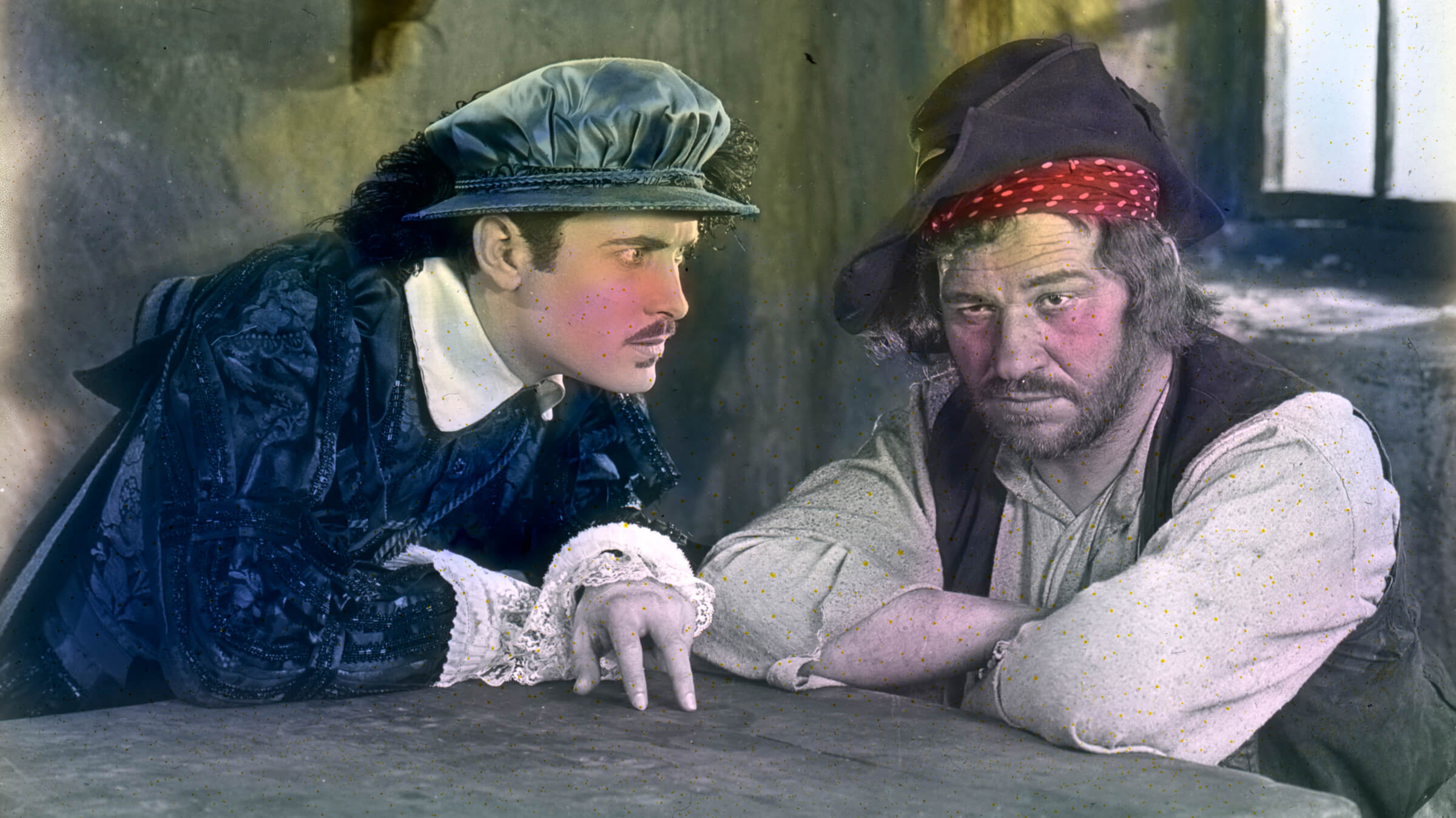This feature was published in conjunction with the screening of The Sea Hawk at SFSFF 2024
Few characters are more beloved in adventure films than the aristocrat taking a walk on the wild side. As W.S. Gilbert put it, “They are no members of the common throng; They are all noblemen who have gone wrong.” But why exactly they chose to take that walk depends on the film.
For Revenge
The Black Pirate was a showcase for cutting-edge natural color but the expensive technology was in support of a picture designed to appeal to nostalgia, lovers of childhood tales and fans of illustrator N.C. Wyeth. Audiences were invited via studio copy to “come and dare with this rollicking prince of pirates.” Douglas Fairbanks wrote himself a plum title role as a Spanish aristocrat going undercover as a buccaneer. Marketing and Fairbanksian charm aside, it’s a bloody tale of revenge—they killed his father, prepare to die—complete with stabbings, slashings, double-crossings, and walking the plank.
Milton Sills as Sir Oliver in The Sea Hawk plays a longer game, living with and raiding alongside Barbary corsairs. Hardly what would be expected of an Elizabethan gentleman but when that gentleman is framed for murder, he must improvise. Sir Oliver’s “Sir” was a reward for his work as a privateer under the command of Queen Elizabeth, so his turn to full piracy does not surprise his former friends in England. However, privateer or not, scenes in which he wields a bloodstained chain against his enemies were thrilling to moviegoers.
René Creste, assisted by Eduard Mathé as his tweedy brother, sought his revenge in a dozen serial chapters as the proto-superhero Judex. Nobody can argue with his commitment, converting his chateau into a high-tech hideout bristling with surveillance, donning a cape, stalking both criminals and their victims, kidnapping his worst enemy, and, when necessary, delivering threats against his foes via trained poodle. Judex’s target is a wealthy banker but his mission is nearly derailed by the machinations of Musidora’s adventuress, who matches him in both guile and style.
For Duty and Honor
The Foreign Legion was especially attractive to gentry needing to leave their homes in a hurry and the most famous legionnaire story, Beau Geste, includes not one, not two, but three well-bred young men who join up in order to frame themselves for the theft of the Blue Water jewel. The stolen gem in their possession is actually paste, the original sold for money by their bankrupt patroness. Ronald Colman as Beau knows that it is a fake, but this fact is a secret worth facing sand, sun, and a military uprising to protect.
Ashes of Vengeance can be seen as director Frank Lloyd’s dry run for The Sea Hawk. The film features a claustrophobic tower battle, a priest rappelling down the walls to fetch help, trunk hose in abundance, and Wallace Beery swallowing the scenery whole. The lavish Norma Talmadge vehicle splashes out a fortune to recreate Parisian splendor in full scale, but the action mostly takes place in the French countryside. Conway Tearle plays a nobleman obliged to enter the service of his enemy thanks to a misjudged vow and is employed as Miss Talmadge’s bodyguard.
When Henry Claremont discovers that his uncle was poisoned, his cousin Elda kidnapped and sold to the circus, and his family’s grand ancestral estate now in the hands of the perpetrator, he transforms himself into the Jockey of Death. Henry slips into a skeleton body stocking and joins the circus troupe, using his equestrian skills to perform death-defying stunts while he attempts to track down his missing cousin. Elda matches his acrobatic prowess and saves both herself and her rescuer with her tightrope bicycle riding.
For the Hell of It
And there was no gentleman more roguish than A.J. Raffles, the posh and polished cricketeer by day and amateur thief by night. His sporting celebrity gives him access to the best homes, allowing him to make off with all manner of valuables, aided by his doting partner and biographer, Bunny. The Raffles character was adapted to the silent screen several times, most notably Raffles, the Amateur Cracksman (1917) with John Barrymore in the title role and Frank Morgan as the devoted Bunny. Barrymore plays Raffles as a gleeful thief, delighted by his own cleverness and the beauty of the loot that passes through his hands. House Peters took the role eight years later, battling the machinations of Hedda Hopper in a film simply titled Raffles. In both cases, the sportsman-thief is not nearly as incorrigible as his print counterpart and ends up abandoning crime, cricket, and Bunny for a refined maiden. Raffles of the E.W. Hornung novels kept his crime wave going for several sequels.
However, just because a gentleman turns to a life of crime doesn’t mean he has to actually commit any thefts. Richard Barthelmess took on the lead role in Ranson’s Folly, playing an officer and a gentleman who is horrified when peace breaks out and he is forced to sit around a western fort with nothing to do but picnics and teas. So, he decides to hold up a few stagecoaches for the adrenaline rush, as one does. Not to actually steal anything, mind, just for the excitement. It’s all fun and games until a real robbery takes place and playing bandit turns out not to be the best alibi at a court martial.

